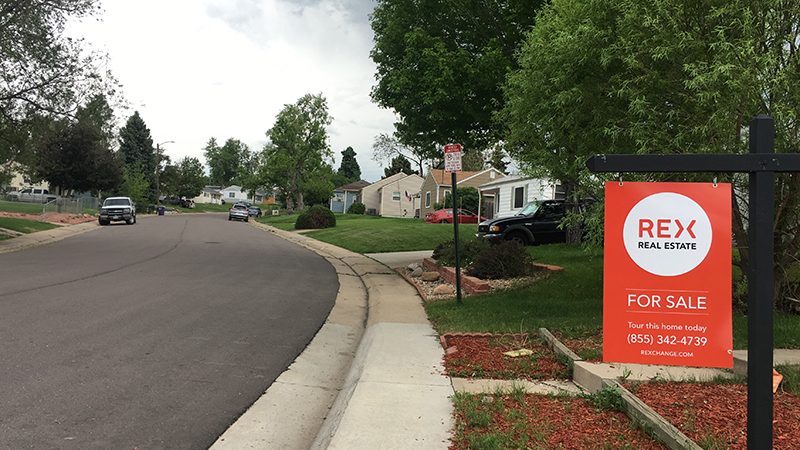
Ruby Hill is one of several Denver neighborhoods with demographics suggesting it could experience gentrification in the near future, according to a University of Colorado Denver researcher. Photo by Kristin Jones
Ruby Hill is one of several Denver neighborhoods with demographics suggesting it could experience gentrification in the near future, according to a University of Colorado Denver researcher. Photo by Kristin Jones
Athmar Park, Globeville, Ruby Hill and Westwood may be the next Denver neighborhoods to gentrify, according to a researcher at the University of Colorado Denver.
Jeremy Németh, PhD, an associate professor of urban and regional planning at CU Denver, reached that conclusion with a tool he recently published in the Journal of Urban Affairs with co-author Alessandro Rigolon, PhD of the University of Illinois at Urbana-Champaign.
The two have argued that gentrification isn’t inevitable. Their model for predicting gentrification is based on a study of neighborhoods in Baltimore, Chicago, Los Angeles, New York, San Francisco and Washington DC that were deemed “gentrification-eligible” in 2000. All of them had high shares of renters, low average incomes and a high percentage of people of color.
By 2015, some had gentrified and some hadn’t. What was the difference?
Previous studies have pinpointed historic housing stock or a lack of affordable housing prices as the determining factors. But Németh and Rigolon found that a much wider variety of factors came into play.
Gentrified neighborhoods typically had historic and multifamily housing units; a close proximity to the city’s downtown area; and access to public transit, the study found. They also had mixed-use developments that provided residents nearby access to local restaurants, shops and businesses, said Németh.
The residents in the gentrified neighborhoods tended to have less formal education and were burdened by housing costs (i.e., they paid more than 30 to 40 percent of their income to pay rent or mortgages), he said.
In line with previous studies, Németh and Rigolon’s analysis found that racially or ethnically diverse neighborhoods were more likely to gentrify than neighborhoods with mostly Black and Latino residents. This doesn’t, the authors clarified, indicate that majority-Black and majority-Latino neighborhoods will ultimately avoid gentrification; rather, it suggests that affluent white gentrifiers “might be reluctant to move to neighborhoods with very high shares of people of color, likely due to widespread stereotypes that such neighborhoods have low-quality schools and high crime rates.”
The success of policies in stemming the worst effects of gentrification varied by region. In some regions, certain kinds of subsidized housing helped keep low-income residents from being displaced. Overall, the researchers found that tenant protections—like rent control and anti-eviction ordinances—are “really important” in preventing gentrification, said Németh.
Crucially, community activists who put their energy into actively preventing gentrification through policy advocacy have seen success, said Németh. Among recent examples of this was the grassroots campaign in the New York City borough of Queens to prevent Amazon from building a new headquarters there.
By contrast, places that are “intoxicated by the development”—viewing it with an attitude of “finally, people are paying attention to our city; our property values are going up”—aren’t faring as well when it comes to balancing the benefits of the growth and preventing displacement, said Németh.
He believes Denver falls more in this category.
“We’re excited by [the growth]. It does feel good. I’m a homeowner—I know it feels good to me,” Németh said. “And yet, I see what it’s doing to people who are not in my same position. It’s dangerous. … We’re uprooting people from not just their homes, but their livelihoods, their sense of place, their sense of home. There are really damaging consequences for that.”
According to a 2015 report published in Governing magazine, Denver ranks seventh out of the top 50 largest U.S. cities in terms of rate of gentrification since 2000. With 24 tracts gentrifying during that time period—representing 42.1 percent of the total tracts deemed eligible to gentrify (eligible tracts were classified as having median household incomes and home values both in the bottom 40th percentile of all city tracts as of 2000)—the Mile High City is gentrifying to a greater degree than Austin, New York City and Philadelphia, among other growing metro areas.
Németh said a main finding of the research was gentrification is controllable. He hopes to combat an attitude of helplessness he often sees among policy makers and community leaders of “throwing their hands up and saying, ‘This is just the market acting in the way that it does, and we can’t really do much about that.’”
Disadvantaged residents who remain in place after their neighborhood gentrifies often report a diminished sense of community. One study of rapidly gentrifying Chicago communities found that low-income, elderly Latinos who stayed in place reported finding limited spaces where they felt welcome; another study of a Melbourne, Australia neighborhood showed that gentrification caused low-income residents to experience a sense of “loss of place.”
The Denver neighborhoods that may be next in line to gentrify—Athmar Park, Globeville, Ruby Hill and Westwood—currently have high percentages of renters and low-income residents; a relatively low percentage of college-educated residents; and low home values, said Németh. That said, they’re fairly close to the downtown area and job centers, and have decent public transit options, making them vulnerable to rapid change.
To help promote sustainable, positive change in communities threatened by gentrification, Németh believes there should be a focus on linking research to policy, and encouraging community and political engagement. He encourages residents to get involved in the electoral process, and also urges city council members to inform their communities about the issue.